Scientific name
Charops bicolor (Szépligeti)
Taxonomic position
Hymenoptera: Ichneumonoidea: Ichneumonidae: Campopleginae
Diagnosis
The genus is distinguished by the emarginate eyes, short ovipositor, nature of the mesopleural suture and first abdominal tergite, absence of areolet and the lower outer angle on second discoidal cell being a right angle. Female: Head and mesosoma black, antennae dark brown to black, metasoma / gaster yellowish, legs more or less yellowish. Head with temples very narrow, short and broad, of lenticular shape (Fig. 1). Inner margin of eye distinctly emarginate near antennal socket. Pronotum narrow with a deep groove. Petiole long and slender, without a lateral pit or groove in front of the spiracle, cross section of petiole near its basal third almost circular and rather smooth. Fore wing venation without areolet. Ovipositor short, about equal to the apical depth of abdomen; ovipositor sheath less than twice as long as height of gaster near insertion of ovipositor. Hind tarsus slender, with first segment shorter than rest of the four segments together.
 Fig. 1. Head (arrow marks indicate emarginate eyes) Fig. 1. Head (arrow marks indicate emarginate eyes)
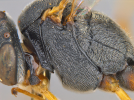
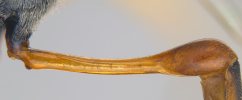 Fig. 2. Mesopleuron, lateral view; Fig. 3. Abdominal tergite 1, lateral view
Male: Fig. 2. Mesopleuron, lateral view; Fig. 3. Abdominal tergite 1, lateral view
Male: Similar to female in all respects except that the abdominal apex is black; first tarsal segment 1.6x as long as the longer hind tibial spur. Charops bicolor belongs to the brachypterum-group of species and can be differentiated from the latter by the male genitalia and
the largely yellowish brown colour of the hind legs. Gupta & Maheshwary (1970) have provided a key to the Indian species of Charops with detailed descriptions and illustrations. Images
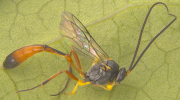
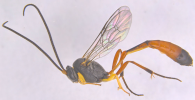
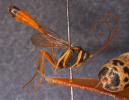
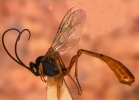 Adult female, lateral view Adult female, lateral view
Distribution
Widely distributed in the Oriental region, including India (Himachal Pradesh, Uttar Pradesh, Andhra Pradesh, Bihar, Tamil Nadu, Kerala, West Bengal, Assam); Pakistan; Thailand; Sri Lanka; China; Taiwan; Japan; Korea; Australia and Malaysia (Gupta & Maheshwary, 1970).
Hosts / Biology
Members of the genus Charops are known to parasitise the larvae of lepidopterous stem borers belonging to 13 families. Most species are specialized parasitoids of mostly noctuid larvae
as koinobiont endoparasitoids. C. bicolor is commonly collected in association with stem borers on rice.
Recorded hosts include Naranga aenescens, N. diffusa, Anomis flava, Pelopidas mathias, Psalis pennatula, Leucania loreyi, Spodoptera mauritia, Scirpophaga incertulas (Gupta & Maheshwary, 1970).
References
- Gupta, V. K. and Maheshwary, S. 1970. Indian species of Charops Holmgren (Hymenoptera: Ichneumonidae), Oriental insects, 4(4): 453-480.
- Polaszek, A. 1998. African cereal stem borers: Economic importance, taxonomy, natural enemies and control (Ed. A. Polaszek). CAB International / CTA. 530 p.
|